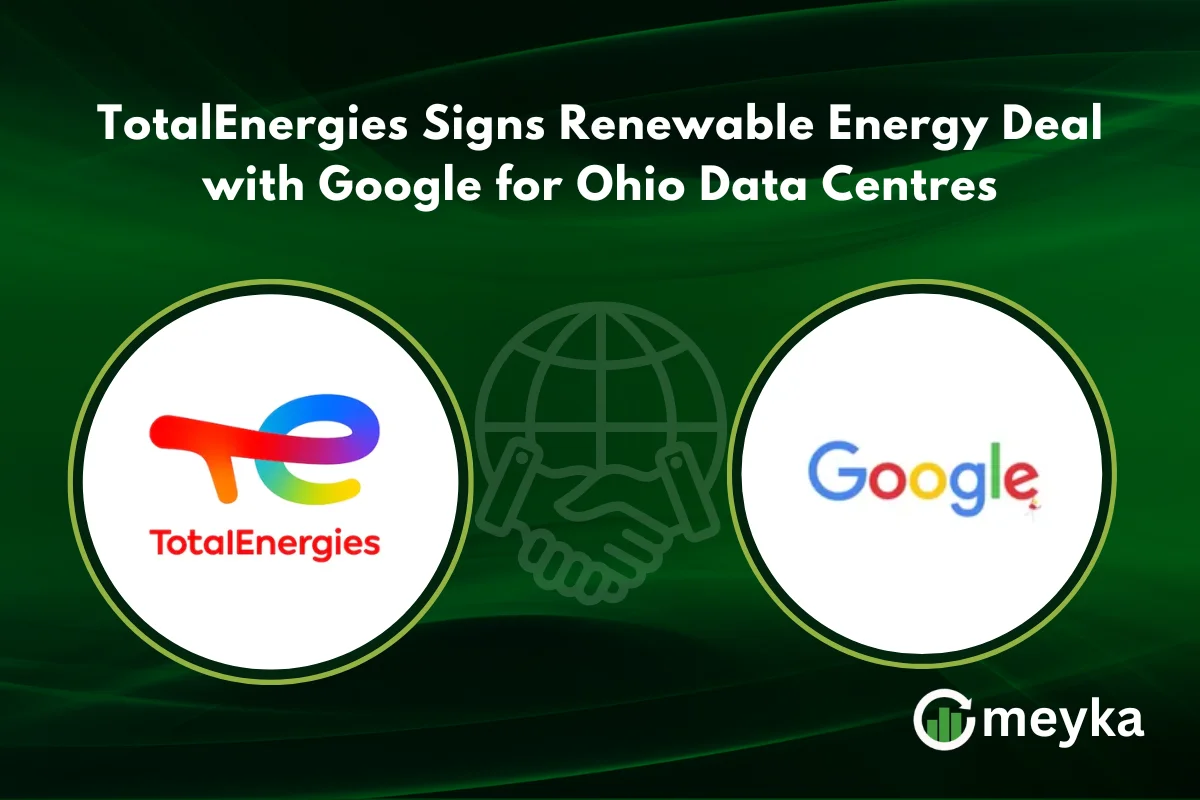TotalEnergies Signs Renewable Energy Deal with Google for Ohio Data Centres
The global energy company TotalEnergies has taken a bold step into the future by signing a long-term renewable power deal with tech giant Google to supply electricity to data-centre operations in Ohio. The arrangement marks both an energy-industry pivot and a signal for investors looking at the stock market, renewable energy and infrastructure plays.
Details of the Power Purchase Agreement
TotalEnergies announced it has entered into a 15-year power purchase agreement (PPA) with Google. The agreement will see the delivery of 1.5 terawatt-hours (TWh) of certified renewable electricity from its Montpelier solar farm in Ohio.
The solar facility is nearing completion and is connected to the PJM electricity grid, the largest regional power market in the United States. Under the deal, Google’s Ohio data-centre operations will draw on this clean power supply, helping the company meet its sustainability and infrastructure goals.
Why This Deal Matters for TotalEnergies
For TotalEnergies, the deal is more than just a supply contract; it reflects a strategic shift. The company has traditionally been known as a major oil and gas producer, but this agreement signals its growing role in renewables and clean power.
By securing a long‐term contract with a major tech player like Google, TotalEnergies:
- Gains a reliable revenue stream that is less tied to the volatility of oil & gas markets.
- Strengthens its credentials in clean energy and improves its standing with investors who care about sustainability.
- Positions itself in the booming infrastructure around digital services, cloud computing and AI data centres, areas expected to grow rapidly.
In short, when we consider TotalEnergies for stock market positioning, this is a meaningful milestone.
Implications for the Stock Market and Stock Research
From an investor’s perspective, this deal touches several themes:
- Growth beyond hydrocarbons: TotalEnergies’ pivot shows energy companies are adapting. For those researching stocks in the energy sector or scanning for alternative growth stories, this is a key data point.
- Infrastructure meets tech: Because the contract involves data centres, a critical part of the digital economy and AI infrastructure, the link to “AI stocks” becomes real. Investors often view tech companies and growth plays separately, but here we see an energy company’s involvement in tech infrastructure.
- Risk and reward: Even as the deal looks favourable, risks remain: project execution, regulatory changes, grid constraints or cost pressures could affect outcomes. Stock research should weigh both opportunity and risk.
- Sustainability focus: Companies that deliver on clean energy deals may attract capital from ESG-focused funds and long-term investors. This may support TotalEnergies’ valuation in ways beyond traditional metrics.
Thus, when analysing TotalEnergies, one should not see it just as an oil major, but also as a player in the emerging intersection of energy, sustainability and tech infrastructure.
Technical and Operational Highlights
The Montpelier solar farm in Ohio is central to the deal. It is designed to supply the PJM grid, which covers much of the U.S. Mid‐Atlantic and Midwest. This ensures the supplied power is integrated with one of the more mature U.S. power markets. TotalEnergies has indicated its intent to expand its U.S. renewable portfolio: for example, solar, wind and storage are key components of its strategy.
The deal also shows how big tech firms like Google are locking in renewable supply contracts to power their growing data-centre infrastructure. The demand for clean, reliable power a large scale is rising fast. This allows companies like TotalEnergies to capture that growth.
Challenges and Watch Points for Investors
While the deal is strategic, investors undertaking stock research should keep the following in mind:
- Execution risk: The solar project must meet schedules, regulatory approvals and performance expectations. Delays or underperformance could reduce the expected benefit.
- Market & competition risk: Renewable energy markets are becoming crowded. Competition may drive down margins. TotalEnergies must maintain cost discipline and scale.
- Grid/market risk: Power markets like PJM have dynamic rules, pricing pressures and regulatory scrutiny. Supply agreements must factor in these variables.
- Valuation risk: Investors may already expect the benefit of such deals to show up in earnings or profitability. If the market perceives that growth is priced in, future upside may be constrained.
For those looking at the stock market and growth themes, TotalEnergies’ foray into this space is promising, but not without caveats.
What It Means Going Forward
What should investors and stakeholders watch? Here are some key items:
- TotalEnergies’ renewables growth rate: How quickly it adds capacity, executes contracts and turns them into earnings will matter.
- Updates on the solar farm’s performance, completion timing and connection to the grid.
- Further deals of a similar nature with other tech/data centre operators will signal whether the company is scaling its business in this domain.
- How the market values this shift: Does TotalEnergies’ role in clean infrastructure drive higher valuations, or is it considered a cost burden?
- The interplay between energy infrastructure and tech/AI growth: as data centres increase, energy demand grows and companies that supply the power become critical players.
For broader portfolios, TotalEnergies may become part of alternative themes beyond fossil fuel exposure. It may interest investors who ordinarily look at “AI stocks” and tech, but wish to diversify into the infrastructure enabling that tech.
Conclusion
TotalEnergies’ 15-year deal to supply Google’s Ohio data centres with renewable power marks a milestone for the company and for energy-tech convergence. It shifts the narrative for the company from oil and gas to clean power infrastructure. For the keyword TotalEnergies, this development offers a compelling storyline for investors conducting stock research and considering how energy companies are evolving in the modern stock market.
We believe this deal should be seen not just as a one-off contract but as a strategic direction. For investors, TotalEnergies represents an energy sector company stepping into the growth domain of tech infrastructure, data centres and sustainability. As with any investment, execution and market conditions will determine the ultimate payoff, but the path is now clear.
FAQs
TotalEnergies signed a 15-year power purchase agreement to supply Google with roughly 1.5 TWh of certified renewable electricity from its Montpelier solar farm in Ohio via the PJM grid.
The deal shows TotalEnergies diversifying into renewable infrastructure, aligning with sustainability trends and providing potential growth beyond traditional oil and gas. For stock research, this makes the company part of both energy and tech-infrastructure narratives.
Key risks include project execution, renewable competition and margin pressure, grid regulatory changes, and whether the market has already priced in the benefits. As always in the stock market, growth expectations must be balanced with real delivery.
Disclaimer:
The content shared by Meyka AI PTY LTD is solely for research and informational purposes. Meyka is not a financial advisory service, and the information provided should not be considered investment or trading advice.






